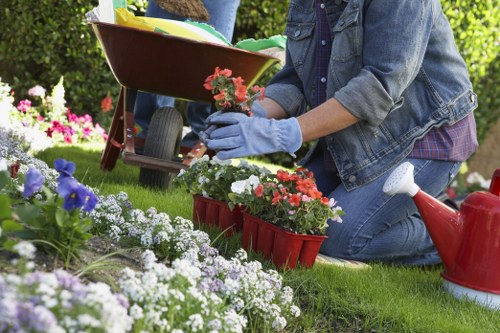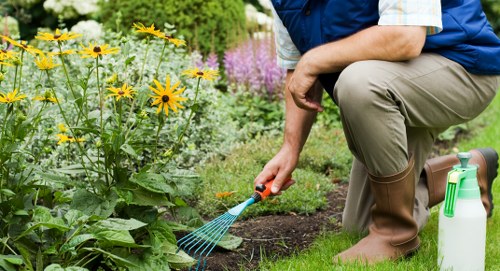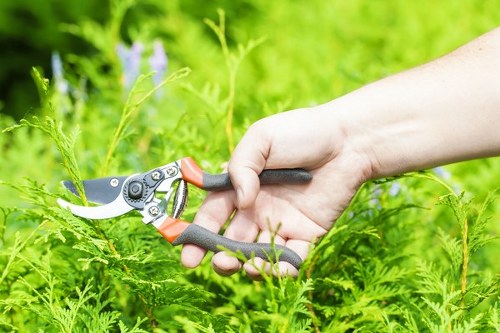The Ultimate Guide to Garden Clearance in Gardening Services

What is Garden Clearance?
Garden clearance involves the comprehensive removal of unwanted vegetation, debris, and outdated garden elements to rejuvenate and prepare your outdoor space for new projects. Whether you're planning to redesign your garden, prepare for landscaping, or simply declutter, garden clearance is a crucial first step.
Professional garden clearance services handle everything from cutting back overgrown shrubs to removing fallen leaves and branches. This process ensures your garden is clean, safe, and ready for any new additions or seasonal changes.
Effective garden clearance not only enhances the aesthetic appeal of your garden but also promotes the health of your plants by eliminating pests and diseases that can thrive in cluttered environments.

Importance of Garden Clearance
Maintaining a clutter-free garden is essential for several reasons. Firstly, it improves the overall appearance of your property, making it more inviting and enjoyable. A well-kept garden can significantly boost your home's curb appeal, potentially increasing its market value.
Secondly, regular garden clearance helps in preventing the spread of diseases among plants. By removing dead leaves and branches, you eliminate potential breeding grounds for pests and fungi, ensuring a healthier garden ecosystem.
Additionally, garden clearance is vital for safety. Overgrown plants and accumulated debris can pose risks, especially during adverse weather conditions. Clearing these hazards reduces the likelihood of accidents and ensures a safer outdoor environment for your family.

When to Consider Garden Clearance
Deciding the right time for garden clearance depends on several factors, including the season, the specific needs of your garden, and any upcoming landscaping projects. Typically, spring and autumn are ideal times for comprehensive garden clearance as they align with the planting and preparation cycles.
During spring, garden clearance prepares your garden for the upcoming growing season. It involves removing winter debris, pruning overgrown plants, and preparing the soil for new plantings. In autumn, clearance focuses on cleaning up after the growing season, removing fallen leaves, and protecting plants against winter damage.
Additionally, consider garden clearance when you're planning to undertake significant landscaping projects or redesign your garden layout. Clearing existing clutter provides a clean slate, making it easier to implement new designs and plantings effectively.

Benefits of Professional Garden Clearance Services
Hiring professional garden clearance services offers numerous advantages over DIY approaches. Experts bring the right tools, knowledge, and experience to handle all aspects of garden clearance efficiently and safely.
Professional gardeners can identify and remove potential hazards that amateurs might overlook, such as invasive plant species or structural issues within your garden. Their expertise ensures that the clearance process enhances the health and beauty of your garden.
Moreover, outsourcing garden clearance saves you time and effort. Instead of dedicating your weekends to strenuous garden work, you can rely on professionals to deliver swift and effective results, allowing you to enjoy your garden without the stress of maintenance.

Steps Involved in Garden Clearance
1. Assessment and Planning
The initial step involves a thorough assessment of your garden to identify areas that require attention. Professionals evaluate the extent of overgrowth, types of debris, and specific needs based on your gardening goals.
2. Removal of Unwanted Vegetation
Once the assessment is complete, the next step is to remove unwanted plants, shrubs, and trees. This process may include pruning, trimming, or complete removal, depending on the condition and type of vegetation.
3. Debris Collection and Disposal
After clearing the vegetation, all debris such as fallen leaves, branches, and other organic matter are collected. Proper disposal methods are employed to ensure that the waste does not negatively impact your property's environment.
4. Soil Preparation
Preparing the soil is crucial for the upcoming planting activities. This step may involve aerating the soil, adding compost, and ensuring optimal nutrient levels to support healthy plant growth.
5. Final Cleanup and Inspection
The final phase includes a thorough cleanup of the cleared areas and a detailed inspection to ensure that every aspect of the garden meets the desired standards. This guarantees a pristine and ready-to-use garden space.
Garden clearance is a vital service that lays the foundation for a beautiful, healthy, and well-maintained garden. By understanding its importance and the steps involved, you can make informed decisions to enhance your outdoor living spaces.
Choosing the Right Garden Clearance Service
Selecting a reliable and professional garden clearance service is essential for achieving the best results. Here are some factors to consider:
- Experience: Look for services with a proven track record and extensive experience in garden clearance.
- Licensing and Insurance: Ensure that the service provider is fully licensed and insured to protect against any unforeseen incidents.
- Equipment: Professional services should have the necessary tools and machinery to handle large-scale clearance efficiently.
- Customer Reviews: Check testimonials and reviews to gauge the quality of service and customer satisfaction.
- Comprehensive Services: Opt for services that offer a complete range of clearance and maintenance options to meet all your garden needs.
By considering these factors, you can select a garden clearance service that aligns with your requirements and ensures a seamless clearance process.
Environmental Considerations in Garden Clearance
Eco-friendly garden clearance practices are increasingly important as we strive to protect the environment. Sustainable clearance methods minimize waste and promote recycling and composting.
Professional services often employ techniques such as mulching, where plant debris is broken down and returned to the soil as natural fertilizer. This not only reduces waste but also enhances soil health, supporting the growth of vibrant and resilient plants.
Furthermore, responsible disposal of non-organic waste ensures that harmful materials do not contaminate the environment. Choosing a garden clearance service committed to sustainability contributes to the overall health of your local ecosystem.
Maximizing Your Garden’s Potential Post-Clearance
After completing garden clearance, it's time to reap the benefits by enhancing your outdoor space. Here are some ideas to maximize your garden's potential:
- Landscape Design: Incorporate new plants, flowers, and structures to create a visually appealing design.
- Gardening Beds: Establish well-defined gardening beds for organized planting and easy maintenance.
- Water Features: Add fountains or ponds to introduce a soothing element to your garden.
- Pathways: Create clear pathways to navigate through your garden effortlessly.
- Lighting: Install garden lighting to highlight key features and extend usability into the evening hours.
These enhancements can transform your garden into a beautiful and functional space, allowing you to enjoy nature and outdoor activities to the fullest.
Maintenance Tips After Garden Clearance
Maintaining a clear and healthy garden requires ongoing effort. Here are some maintenance tips to keep your garden in top condition:
- Regular Weeding: Keep weeds under control to prevent them from overtaking your plants and garden beds.
- Pruning: Trim overgrown branches and dead foliage to promote healthy plant growth and prevent disease.
- Composting: Recycle garden waste by composting, which enriches your soil naturally.
- Seasonal Cleanups: Perform thorough cleanups during seasonal transitions to prepare your garden for upcoming changes.
- Inspection: Regularly inspect your garden for signs of pests or diseases and address issues promptly.
Consistent maintenance ensures that your garden remains beautiful, healthy, and enjoyable throughout the year.
Cost Considerations for Garden Clearance Services
The cost of garden clearance services can vary based on several factors, including the size of your garden, the extent of clearance required, and the specific services you need. Understanding these factors can help you budget effectively:
- Garden Size: Larger gardens typically require more time and resources, affecting the overall cost.
- Type of Vegetation: Dense or overgrown areas with trees and shrubs may necessitate specialized equipment and expertise, increasing expenses.
- Service Scope: Comprehensive clearance that includes debris removal, pruning, and soil preparation will generally cost more than basic clearance.
- Frequency: Regular maintenance contracts may offer better value compared to one-time services.
- Location: Accessibility and location can influence pricing, especially if the garden is in a remote or difficult-to-reach area.
It's advisable to obtain multiple quotes and compare services to ensure you receive the best value for your investment in garden clearance.
DIY vs. Professional Garden Clearance
While some homeowners may consider tackling garden clearance themselves, there are several reasons why hiring professionals is often the better choice.
Advantages of DIY:
- Cost Savings: Doing it yourself can save money on labor costs.
- Personal Satisfaction: Completing the work yourself can provide a sense of accomplishment.
Disadvantages of DIY:
- Time-Consuming: Garden clearance can be a lengthy process, especially for large gardens.
- Safety Risks: Handling heavy debris and using equipment can pose safety hazards.
- Limited Expertise: Lack of professional knowledge may result in incomplete or ineffective clearance.
In contrast, professional garden clearance services offer expertise, efficiency, and safety, ensuring that your garden is cleared thoroughly and prepared for future projects with minimal hassle.
Common Challenges in Garden Clearance
Garden clearance can present several challenges that require careful planning and execution:
- Overgrown Vegetation: Managing areas with dense and overgrown plants can be physically demanding and time-consuming.
- Removal of Large Debris: Handling large branches, tree stumps, and other substantial debris requires specialized equipment.
- Pest Control: Identifying and addressing pest infestations during clearance is crucial to prevent future issues.
- Soil Condition: Poor soil health may complicate clearance efforts and affect subsequent garden projects.
- Weather Conditions: Unfavorable weather can hinder the garden clearance process, delaying projects.
Professional garden clearance services are equipped to handle these challenges effectively, ensuring a smooth and successful clearance process.
Innovative Tools and Techniques in Garden Clearance
Advancements in gardening tools and techniques have made garden clearance more efficient and environmentally friendly. Some of these innovations include:
- Mulching Machines: These machines efficiently break down plant debris into mulch, which can be reused to enrich the soil.
- Chainsaws and Hedge Trimmers: Modern, lightweight equipment makes the removal of large branches and hedges more manageable.
- Eco-Friendly Disposal: Sustainable disposal methods, such as composting and recycling, minimize environmental impact.
- Automated Tools: Robotic and automated tools can assist in clearing hard-to-reach areas with precision.
- Sustainable Practices: Techniques like permaculture and organic gardening promote long-term garden health and sustainability.
Incorporating these tools and techniques enhances the efficiency and effectiveness of garden clearance, ensuring a high-quality outcome.
Preparing for Garden Clearance
Proper preparation is essential for a successful garden clearance project. Here are some steps to consider:
- Set Clear Objectives: Define what you aim to achieve with the clearance, such as preparing for new plantings or improving garden aesthetics.
- Assess the Garden: Evaluate the current state of your garden to determine the extent of clearance required.
- Gather Necessary Tools: Ensure you have all the required equipment, or confirm that your professional service will provide them.
- Plan the Timeline: Establish a clear timeline to manage the clearance process efficiently.
- Inform Stakeholders: If you have family members or neighbors who might be affected, communicate your plans to avoid inconvenience.
By following these preparatory steps, you can facilitate a smooth and effective garden clearance process.
Post-Clearance Garden Care
After completing garden clearance, ongoing care is essential to maintain the benefits achieved. Here are some post-clearance care tips:
Regular Maintenance: Continue with regular maintenance tasks such as weeding, pruning, and watering to keep your garden healthy and attractive.
Soil Health: Monitor and improve soil health by adding organic matter, testing pH levels, and ensuring proper drainage.
Plant Selection: Choose plants that are well-suited to your garden's conditions, including climate, soil type, and sunlight exposure. This promotes healthy growth and reduces the need for frequent clearance.
Integrated Pest Management: Implement natural pest control methods to maintain a balanced and thriving garden ecosystem.
By adhering to these post-clearance care practices, you can ensure that your garden remains a beautiful and sustainable space for years to come.
Seasonal Garden Clearance Tips
Each season presents unique challenges and opportunities for garden clearance. Tailoring your clearance activities to the seasons can optimize your garden's health and appearance:
- Spring: Focus on removing winter debris, pruning shrubs, and preparing planting beds for new growth.
- Summer: Manage overgrown plants, control weeds, and ensure adequate watering and ventilation for healthy plant development.
- Autumn: Clear fallen leaves, prepare plants for winter, and mulch garden beds to protect against cold weather.
- Winter: Perform minor clearances, protect vulnerable plants, and plan for spring garden projects.
Adapting your garden clearance efforts to the seasonal changes ensures that your garden remains resilient and vibrant throughout the year.
Common Misconceptions About Garden Clearance
There are several misconceptions surrounding garden clearance that can deter homeowners from undertaking necessary maintenance:
- Garden Clearance is Only for Overgrown Gardens: Even well-maintained gardens benefit from regular clearance to remove dead debris and promote plant health.
- DIY is Cheaper and Better: While DIY can save money, it often lacks the efficiency and expertise that professional services provide, potentially leading to incomplete or subpar clearance.
- Garden Clearance Damages Plants: Proper clearance methods focus on removing unwanted elements without harming healthy plants, enhancing overall garden vitality.
- Seasonal Cleanups are Unnecessary: Each season brings specific challenges that require tailored clearance activities to maintain garden health and appearance.
Understanding these misconceptions helps in making informed decisions about garden clearance, ensuring your garden remains a beautiful and healthy space.
Technology’s Role in Modern Garden Clearance
Advancements in technology have revolutionized garden clearance, making it more efficient and effective. Some notable technological contributions include:
- Automated Equipment: Robotic mowers and automated trimmers reduce manual labor and improve precision in maintaining garden aesthetics.
- GPS Mapping: GPS technology allows for precise mapping and planning of garden clearance activities, ensuring comprehensive coverage.
- Environmental Monitoring: Sensors and data analytics monitor soil health, moisture levels, and plant growth, enabling proactive garden management.
- Eco-Friendly Machinery: Electric and battery-powered tools minimize environmental impact and reduce noise pollution during clearance operations.
- Online Services: Digital platforms make it easier to schedule, track, and manage garden clearance services, enhancing customer convenience.
Integrating these technologies into garden clearance practices enhances efficiency, sustainability, and the overall quality of garden maintenance.
Conclusion
Garden clearance is an essential component of effective gardening services, laying the groundwork for a beautiful, healthy, and sustainable outdoor space. By understanding its importance, timing, and the benefits of professional services, homeowners can maintain gardens that are both aesthetically pleasing and environmentally responsible.
Whether you're embarking on a new landscaping project or simply aiming to keep your garden in pristine condition, investing in comprehensive garden clearance ensures that your efforts yield the best possible results.
Contact us today to schedule your garden clearance service and transform your outdoor space into a haven of beauty and tranquility.